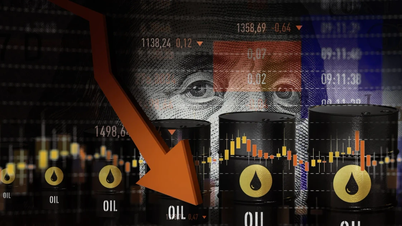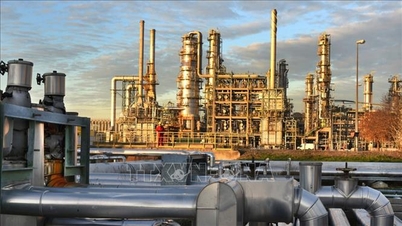In the second half of 2024, the world oil market will be unpredictable, affected by many factors such as the adjustment of production plans by the Organization of the Petroleum Exporting Countries and Allied Oil Producing Countries (OPEC+), conflicting forecasts about oil demand or tensions in the Middle East.
 |
| OPEC+ production increases and different demand forecasts could hold back oil prices. Illustration photo. (Source: Investopedia) |
Signs of market change
A few weeks ago, many energy analysts predicted a global oil price recovery in the second half of 2024, with Brent crude surpassing $90 a barrel. However, the situation changed after OPEC+ announced that it would begin lifting its current production limits in October 2024, earlier than many had expected.
This decision by OPEC+ has led to more abundant oil supply, leading to a drop in oil prices. Although Brent crude oil prices recently exceeded $85/barrel, this news has changed the outlook for the global oil market in the second half of this year.
Many analysts, including Mark Luschini, investment strategist at financial advisory firm Janney Montgomery Scott, have predicted a recovery in oil prices in the second half of the year. Brent crude oil prices rose 20% from the start of the year to mid-April 2024, reaching $93 a barrel, before falling below $80 by the end of May 2024.
However, a better-than-expected global economic recovery and the prospect of central banks cutting interest rates have many analysts viewing the oil price drop as a short-term fluctuation.
According to Mr. Luschini, global economic activity is going better than expected, with regions outside the US growing and the Chinese economy stabilizing. The US Federal Reserve (Fed) may not cut interest rates as soon as analysts previously predicted, with most Fed governors now expecting only one rate cut this year, while many analysts predict several rate cuts.
Mixed predictions
Due to changing expectations about when the Fed might cut interest rates and the possibility of OPEC+ increasing production in the fourth quarter, Mr. Luschini adjusted his Brent price forecast for the second half of 2024 to $80-$85/barrel.
Luschini is not alone, as many other experts are more cautious about a brighter outlook for oil prices in the second half of the year. The US Energy Information Administration (EIA) earlier this month lowered its forecast for average Brent crude oil prices this year from $88 a barrel to $84 a barrel. Shortly after, the International Energy Agency (IEA) also lowered its forecast for global oil demand growth in 2024 by about 100,000 barrels a day to 960,000 barrels a day.
Conflicting demand forecasts could weigh on oil prices. OPEC predicts global demand will grow by 2.2 million barrels a day this year, double the IEA’s estimate. This optimism is one reason OPEC+ is increasing production.
Meanwhile, JP Morgan analysts said some OPEC member countries have exceeded their stated production quotas, and seasonal demand could push crude demand by about 4 million barrels per day until August, reducing current global inventories.
Essentially, the decline in oil inventories could be enough to return Brent prices to highs of around $80-90/barrel by September 2024.
However, investment bank Jefferies is not so sure, based on its recent global energy market report. Jefferies’ oil price forecast of $84 a barrel reflects concerns about easing geopolitical tensions, falling diesel consumption in Europe and a slowing US economy.
The IEA also forecast that total global investment in clean energy in 2024 will be twice that of fossil fuel investment, potentially limiting the upside in oil prices.
Impact of geopolitical tensions
| OPEC+'s decision to possibly increase output earlier than expected and differing demand forecasts could keep oil prices low in the second half of the year. The U.S. Energy Information Administration recently lowered its forecast for Brent crude prices this year. The International Energy Agency also cut its demand forecast. For consumers, increased OPEC+ production could help curb gasoline prices that have fallen recently. |
Escalating political tensions have been a factor that has kept the oil market “heated” since the beginning of 2024. The market has largely “ignored” weak gasoline demand in the US, instead focusing on the possibility of supply disruptions in the Middle East.
In the latest development, Israel deployed troops to its northern border as attacks from Lebanon increased. Analysts at RBC Capital Markets said the possibility of a direct military confrontation between Hezbollah and Israel was becoming increasingly clear. The risk of Iranian involvement or Israeli attacks on Iranian energy facilities posed a significant threat to regional energy supplies.
Israel’s offshore gas operations are vulnerable to potential Hezbollah attacks. Importantly, direct Iranian intervention could spark a wider regional conflict, potentially affecting major oil shipping routes such as the Strait of Hormuz.
Ukraine’s attacks on major Russian refineries also raised the possibility of disruptions to oil supplies from Moscow. Geopolitical conflicts have prompted traders to add a higher risk premium to oil prices, raising the prospect of a tighter market in the coming months due to supply disruptions.
The two major oil contracts, Brent and WTI, both rose more than 6% in June 2024. The outlook for the oil market is positive in the short term. Although weak US gasoline demand and unexpected stockpiles usually put pressure on prices, these factors are currently overshadowed by the potential for supply disruptions due to escalating tensions in the Middle East.
Traders are closely watching developments in the Middle East, as any escalation could trigger a sharp rise in prices. In addition, upcoming US economic data releases will be important in assessing the demand outlook and potential changes in Fed policy.
Source: https://baoquocte.vn/du-bao-su-kho-luong-cua-thi-truong-dau-the-gioi-nua-cuoi-nam-2024-277793.html



![[Photo] Students of Binh Minh Primary School enjoy the full moon festival, receiving the joys of childhood](https://vphoto.vietnam.vn/thumb/1200x675/vietnam/resource/IMAGE/2025/10/3/8cf8abef22fe4471be400a818912cb85)
![[Photo] Prime Minister Pham Minh Chinh chairs meeting to deploy overcoming consequences of storm No. 10](https://vphoto.vietnam.vn/thumb/1200x675/vietnam/resource/IMAGE/2025/10/3/544f420dcc844463898fcbef46247d16)




































































































Comment (0)